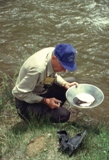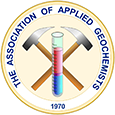PAUL KELLOGG THEOBALD (1928-2005)

Paul Theobald, one of the pioneers in the field of exploration geochemistry, died at his home in Golden, Colorado on July 16, 2005. He was a graduate of Stanford University and spent almost his entire career with the United States Geological Survey (USGS). He was an acknowledged expert in drainage geochemistry, particularly in arid terrains.
Paul began work with the USGS in 1951, “retired” in 1990, but continued to work as a scientist emeritus for the better part of another decade. His extensive contributions to the USGS were recognized through receipt of the Meritorious Service Award in 1985, and the Distinguished Service Award (the highest honorary award granted by the U.S Department of the Interior) in 1992. He contributed in both scientific and management positions throughout his career: as committee member, committee chairman, coordinator, USGS Branch Chief, and supervisory geologist on numerous technical and planning committees, both internally and externally as a USGS representative.
A brief review of programs that he participated in provides an appreciation of the breadth of his contributions to both the USGS and the international scientific community at large: heavy mineral studies in the southern Appalachians; mineral resource investigations in the Berthoud Pass quadrangle, Colorado project (which contributed to the discovery of the Henderson molybdenum deposit by Climax-Amax), mineral resource and geochemical studies of the Selway-Bitterroot Wilderness, Idaho, the Williams Fork / St. Louis Peak Roadless Area, Colorado, the Ajo quadrangle, Arizona, and the San Carlos Apache Indian Reservation, Arizona; assignment to the USGS Mission in Saudi Arabia; geochemical baseline studies in the National Petroleum Reserve, Alaska; geologic mapping and geochemical studies in the Northern Sonora Mexico Project (a joint USA-Mexico project); and geochemical investigations in the Xinjiang-Uygur Autonomous Region, northwestern China.
He was an active member of the Geochemical Society, the American Association for the Advancement of Science, the Society of Economic Geologists, the Colorado Scientific Society, the Geological Society of America, and the Association of Exploration Geochemists (AEG) / Association of Applied Geochemists (AAG).
Paul was the Chairman of the Organizing Committee for the 7th International Geochemical Exploration Symposium (IGES) in Golden in 1978 and, with John Watterson, edited the proceedings volume. He served the AEG as President in 1979 / 1980. He shared his expertise through organization of and contributions to numerous short courses and workshops sponsored by AEG and other scientific groups. He gave the Keynote address at the 13th IGES in Rio de Janeiro in 1989 and, in typical fashion, shared the authorship with his other colleagues.
Two scientific aspects stand out in my mind when I think of Paul, both related to drainage geochemistry. His 1956 paper entitled “The gold pan as a quantitative tool” forewarned of his contributions in the area of heavy mineral geochemistry. How many of us did he introduce to this art? Yes, exploration geochemistry is still both science and art! His early experience with precipitates of aluminum, iron, and manganese at Deer Creek, Summit County, Colorado, resulting in his paper with T.T. Chao in 1976 on “the significance of secondary iron and manganese oxides in geochemical exploration” demonstrated his leadership in labile drainage geochemistry. This paper bridged the gap between the colorimetric analysis days of the 1950s and the rediscovery of selective extraction analysis in the early 1990s.
Many have commented on Paul’s passion for geology. What was even more to his credit was the infectious manner in which he transferred that passion to others. When demonstrating a technique or discussing a concept, Paul often took the devil’s advocate position just to make sure we were really thinking things through for ourselves. Numerous young scientists, both domestic and international, have benefited from Paul’s supportive and challenging mentoring. I’m proud to say that I’m among that special group. Paul was and is a role model for us all. Other passions that Paul enjoyed include wood turning, making musical instruments (Guitar, pipe organ, harpsichord, clavichord, and dulcimer) and fly fishing – particularly for the small, but difficult to catch, brookies found in the Colorado Rockies.
He leaves his wife of 53 years, Jean, daughters Mary Doherty (geochemist – Reno, Nevada) and Catharine Eppinger (Veterinarian – Nederland, Colorado), grandchildren Jonathon, Jessica, Zachary, and Stephanie Doherty, and Paul and Rosemary Eppinger; and sister Martha Peterson (Reno, Nevada).
Memorial contributions may be made to the Distinguished Geochemist Scholarship Fund, Association of Applied Geochemists, P.O. Box 26099, Nepean, Ontario, Canada. K2H 9R0.
December 7, 2005
Graham Closs
Colorado School of Mines
Golden Colorado, U.S.A. 80401
lcloss@mines.edu
